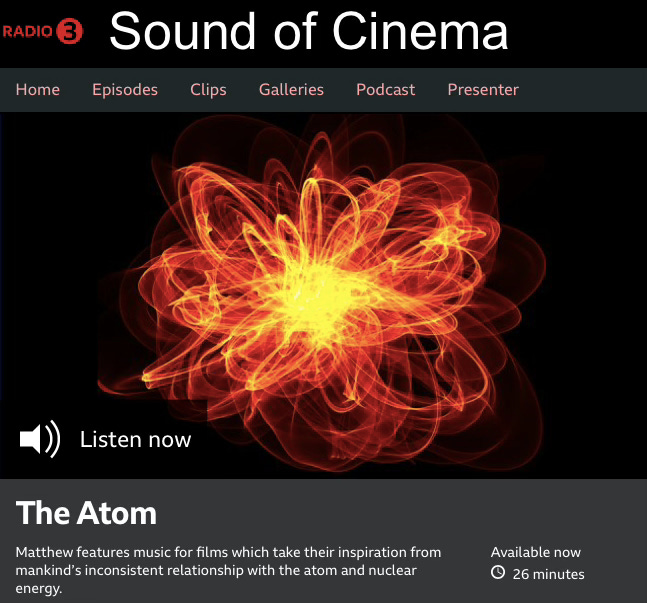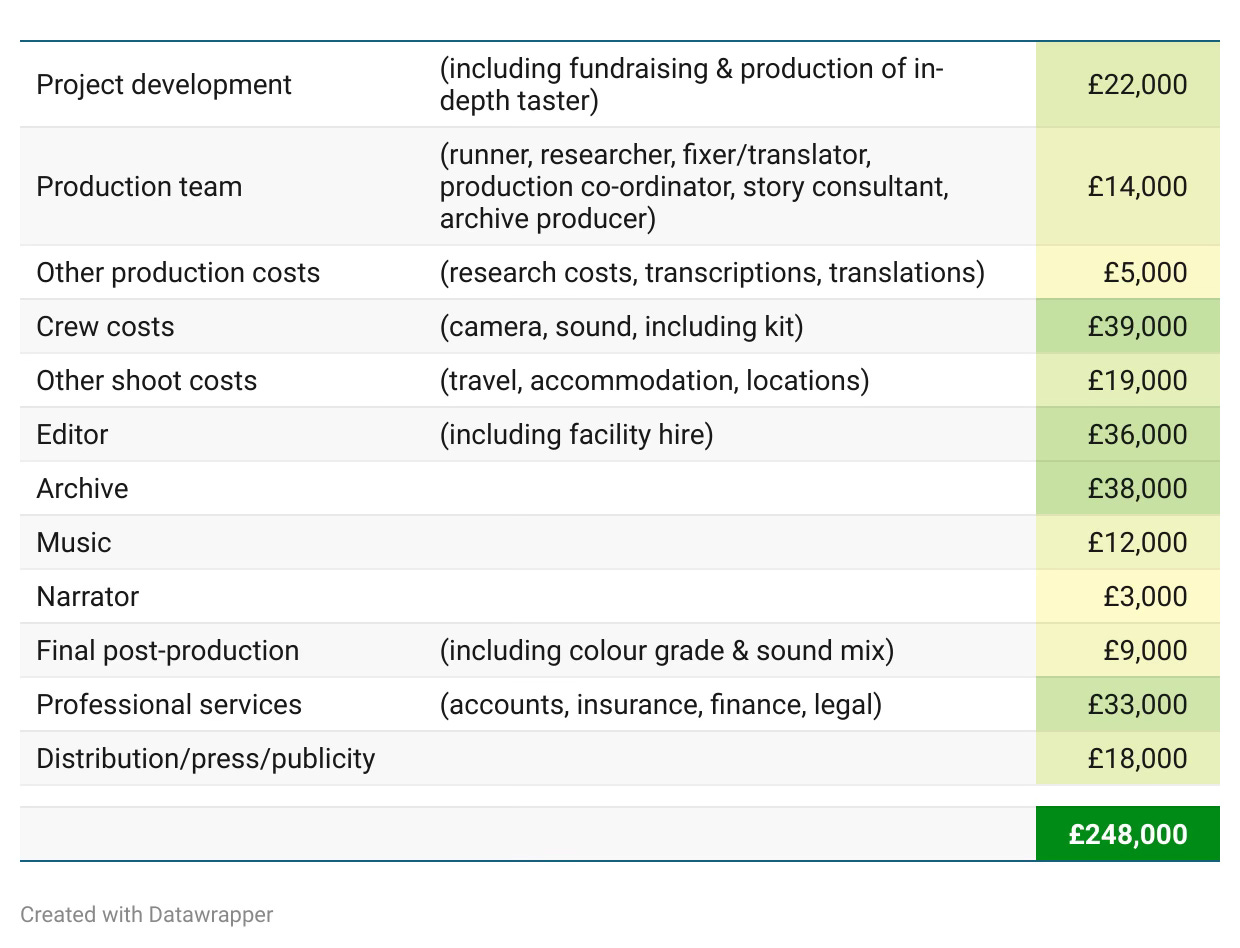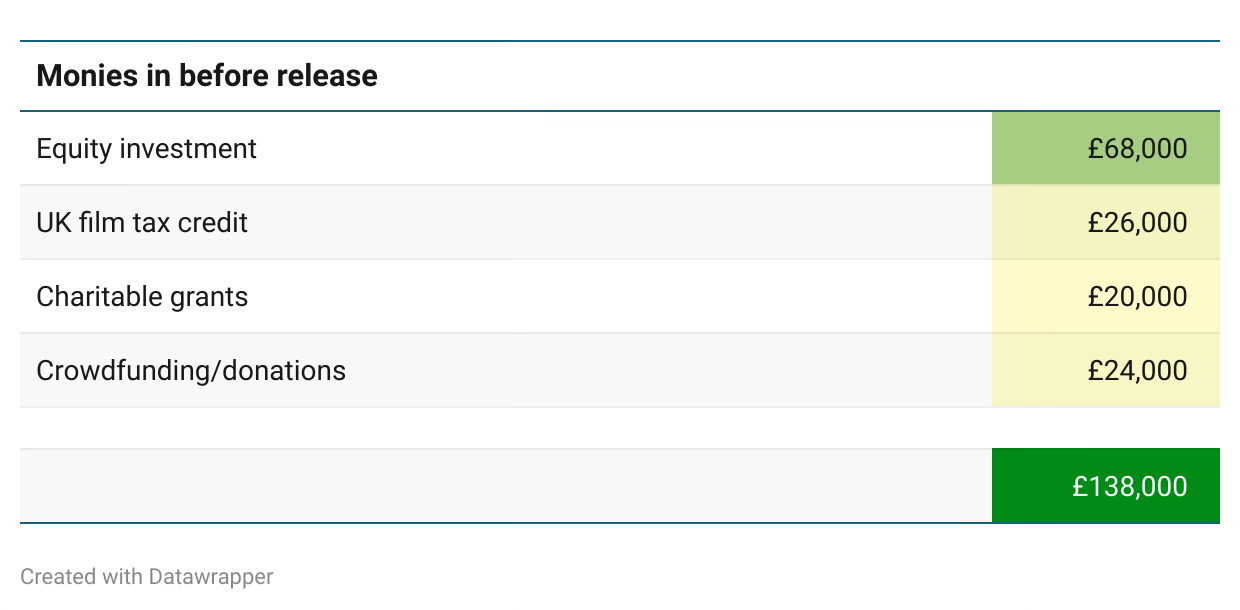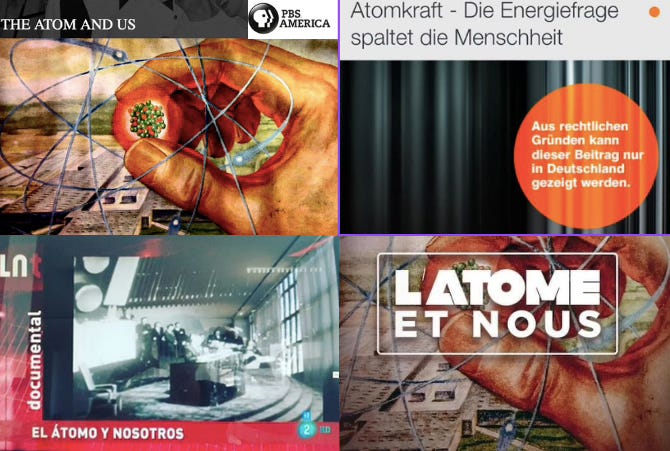I sold my film around the world. But I'm still in debt.
A no-holds-barred case study from the coal face of independent documentary film. With actual £££ numbers.
Before we get going, I want to acknowledge that in sharing this piece, I feel more than usually exposed. It's still not customary for people to talk completely openly and honestly about what they're paid (or not paid) across all sorts of industries, but perhaps especially in the creative industries. Certainly through all my years in the trenches as an independent documentary producer & director, I've seen virtually no case studies like this.
But I WANT to get real and share the actual numbers… even if it does feel scary.
In doing so, I'm taking inspiration from the authentic and vulnerable money conversations I've so appreciated on Substack publications like and , as well as from the nuanced but honest sharing by in her 2023 piece 'Is it wrong to admit how much you earn?' And most of all, from this rallying cry by in her latest piece about the finances of her book launch:
"We are going to be uncomfortably transparent in as many ways as I can because, CREATIVE INDUSTRIES NEED TRANSPARENCY. All creative industries are built around artists feeling like they can’t talk about the business side openly."
So this is me, talking about the business side openly. I hope that it’s the start of more conversations about where the money is - and isn’t - going, both in my world of independent documentary, and in the broader world of art and creative labour more generally.
Let’s dive in.
Firstly, before anyone gets out their violins, this isn't a sob story. I made a film…and it’s been sold…and people have watched it.
I mean, guys, it's on Netflix! Look, there it is - next to Modern Family and Squid Game.1
It's also been sold to Disney+ and to broadcasters all over the world. And despite the body blow of the pandemic - which forced the closure of cinemas a couple of months before my premiere was booked in the summer of 2020 - it's had a decent share of big screen outings, including at my own beloved local, the Duke of York's Picturehouse in Brighton. Not to mention screenings hosted by schools and universities, companies, government agencies, non-profits and community groups, in the UK and beyond.
Here are I am at the film’s festival premiere in 2019 (blissfully unaware of the turmoil that 2020 had in store!)
It was long-listed at the 2020 BIFA’s (British Independent Film Awards) and got a bucketload of mostly great reviews in the press, from all the major British newspapers, as well as radio & TV coverage. The BBC even made a whole programme about atomic movie scores inspired by its release, including an interview with my wonderful composer on the film, Paul Honey.
By almost any yardstick, the film has achieved all I could ever have hoped it would - and more.
It's also important to state at the outset that I'm a straight, white, able-bodied, Oxbridge-educated, Gen X woman from a rich country, in a stable and supportive relationship, whose journey to this point has involved a great deal of privilege (plus proximity to even greater privilege, whose coat tails I've grabbed onto hard).
And I chose to devote a large chunk of my life to pursuing my dream of directing a feature film. No one held a gun to my head. It was what I fervently wanted to do.
And yet...
5 years after the film was released, I'm still in debt.
Last month, I finally cleared the last of my credit card debts on the film, which stood at over £20,000 just before its release in 2020, alongside a UK government 'bounce back' loan I also took out that year.2
But I still owe more than £10,000 in (thankfully interest-free) loans to a couple of individuals who lent me money and to the film's distributors.
Plus, the company that was set up to produce the film still owes me personally tens of thousands of pounds in funds I drip-fed in over the 10+ years I was making it (alongside other TV work and having my two kids), to cover various costs of development, production and post-production.
That's money I know I will never see again.
So how did I end up here? Pull up a pew and I’ll tell you all about it.
I think I'm pretty safe in saying that most people beyond the walled garden of the film industry have little sense of the real costs involved in making films of any size - other than perhaps the huge blockbusters, whose budgets in the tens or even hundreds of millions of dollars get bandied around in the media. Even then, they likely have no real idea where those budgets are going, of who is getting paid and how much.
So what I'm going to do here is actually break down:
how much money was spent making the film - and what it was spent on
where that money came from, and
what income the film has earned since its release and from what sources
Also, before we start and just to be super-clear, this whole endeavour is an example of what film industry sage and visionary
calls "non-dependent cinema" ie it was not commissioned or funded up front by any of the traditional corporate or public broadcasting entities or streamers.I decided to make the film. And then I worked my arse off for years to raise the finance for it as I went along.
Coming from the supported cocoon of factual television as I did3, I found the never-ending slog of raising the money far and away the toughest part of my filmmaking journey. There were many times when I said to myself:
Why are you doing this??!
No-one even asked you to make this film, for God’s sake!
But on the other hand, there were no commissioners trying to force me into making the film in a certain way or argue me out of my creative choices. The film I made is the film I wanted to make.
And that's something that has a value, even if it isn’t a financial one.
So with all that in mind, it’s time to get down to some actual numbers. (Note: all figures have been rounded up or down to the nearest £1000 to keep things as straightforward as possible).
Q. How much did it cost to make the film?
A. The total money actually spent to date is £248,000.
Which breaks down broadly as follows:
I know this is objectively a pretty big sum of money. But in the context of a 90 minute documentary film, especially one with a sizeable amount of overseas filming (in the USA, France & Germany) and with a significant amount of archive and music to clear, it is in fact very modest.
And the reason for that is that the money spent does NOT fully reflect the real cost of the work done.
Perhaps you've already noticed the most obvious way in which this is true?
Did you notice any money for the director or producer in that break down??
Nope. You didn't. Cos it's not there.
That's right. Neither I, nor my executive producer, has ever been paid a penny for our time working on the film (in his case going back as far as 2011 and in mine, even earlier than that).
I was also able to negotiate lower costs elsewhere (including some of the final technical finishing in post, the specially-composed music and narrator), because colleagues understood and recognised the financially-constrained, hand-to-mouth nature of the film and were willing to drop their fees to help get it finished.
Q. How did you fund the cost of making the film?
A. With a patchwork of grants, crowdfunding, equity investment (ie selling shares in the company making the film), the UK film tax credit plus... credit cards, savings, loans from friends & family and years and years of unpaid labour.
Here's a breakdown of the money I was able to raise during the making of the film:
The first money I ever raised was through a proto-form of crowdfunding, before the term had even really been invented4.
I sent an email literally to everyone I had an address for (hello if you’re reading this and you got that original email - I know there are definitely some of you still subscribed to my missives 😃) explaining that I was going to make a feature documentary about nuclear power.
All I needed was for 10,000 people to give me £10 each - hence the name of the production company I created, Tenner Films! I added a very crude Paypal button to the email and to my eternal gratitude, I received donations from dozens of people straight off the bat.
Though note, NOT from 10,000 people.
And second note, if you’re good at sums you may have already spotted that my maths was off: 10,000 people contributing £10 each would amount to £100,000, less than half even of what I ended up spending without paying myself anything at all…
Yet those first donations were critical for me.
In all the years that followed, when people asked why I hadn’t ever given up, I couldn’t really adequately answer them. I just knew inside that I would keep on going until the film was made. I’d told those initial people who showed faith in my idea and gave me their cash that I would make the film.
So I persevered.
Overall, I did four different rounds of crowdfunding, three via the IndieGoGo platform, each time raising more than the last.
And I educated myself about all the other possible avenues available for raising finance, which led to me incorporating Tenner Films as a limited company and selling shares with tax relief for my investors. And later, going through the cultural test process with the British Film Institute to qualify for the UK film tax credit.
Through all of this I was supported by the incredible experience and calm guiding hand of my executive producer Christopher Hird. I always believed I’d get to the finish line. But knowing that someone as talented and well-respected as Christo believed it too - that made a big difference.
Q. How much money has the film made since it was released?
A. The income from all sales sources to date is £61,000, plus we’ve been able to make two more film tax credit claims, making a grand total of £74,000.
Here's the breakdown:
A big chunk of the figure for broadcast comes from sales of a shorter 'TV hour' cut of the film (under the alternative title, 'The Atom & Us') which have been handled by a separate sales agent who takes a 35% share of all sales.
We made this version since most TV channels don't have slots for feature-length documentaries but still tend to programme in either half hour or hour slots. And I'm happy to say that interest from international broadcasters has held up pretty well over the last 5 years, helped I think by it being an internationally-focused film on a perenially 'hot button' topic.
But it also includes income from the jumble of acronyms anyone with a movie to sell these days has to get their heads around - namely, SVOD, TVOD and AVOD (or FAST).
SVOD (subscription video on demand) is basically the streamers, so in the case of this film, it's Netflix and Disney+. Not all the income from these sales - which is shared equally between the film production company and the distributors, after an initial cut taken by an aggregator - has been paid yet, so the figure will rise further.
TVOD - or transactional video on demand - is basically pay per view, so all the online marketplaces where you can pay a one-off fee to rent or buy a single film (eg Apple, Amazon, Google Play, Rakuten, Sky Box Office, even YouTube). The economics of this are generally poor for the filmmaker so my distributors and I took the decision to make the film available on only one TVOD platform, Vimeo-on-Demand. And the income has, as expected, been tiny compared to the other areas.
And finally AVOD - or ad-supported video-on-demand - is an ever-growing market, with a seemingly insatiable demand for content. It encompasses a ballooning number of FAST (free ad-supported TV) channels - famous examples include Roku, Tubi, Pluto, Plex and, still the granddaddy of them all, YouTube.
AVOD is probably most akin to Spotify or Apple Music, in that the amount the creator receives per stream is miniscule. The hope here is for scale - that there will be enough eyeballs eventually to earn a reasonable sum. And depending on the title, this can be a good supplementary source once a film’s in distribution. In my case, the figure right now is low - in the hundreds of pounds rather than the thousands - but the scope for it to increase is definitely there. So fingers crossed!
I did also do a limited run of special edition DVDs for my crowdfunders and since not all of them still even had DVD players by the time the film was released (!) and hence no longer wanted theirs, I had some left over which I sold (it didn't make economic sense to produce any more beyond that first run since DVD sales are essentially dead these days). I also created some bonus content - interview extras and a study/discussion guide to accompany the film - which is available via the film's website. Sales from both sources have come to less than £200.
The other main source of income has been from screenings of the film, encompassing theatrical, semi-theatrical, educational, corporate, non-profit and community screenings.
As I mentioned at the top, the UK cinema release in 2020 ended up having to be swiftly reimagined thanks to the pandemic and so the film had its theatrical release digitally instead, with one of the UK's main independent cinema chains, Curzon, via their home cinema platform. All screenings remained virtual through 2021 until we started to be able to hold screenings physically again from 2022 onwards.
It's hard to tell for sure what impact this has had on the overall income the film has generated. Virtual screenings were so new in 2020 and distributors were feeling their way into uncharted territory at that time.
Perhaps the film would have made more money if there had been no pandemic? Perhaps it would have made less. I guess I will never know the answer to that.
In terms of individual fees for screenings, these have varied wildly, depending on the size and type of audience. The lowest fee was less than a hundred pounds for a one-off virtual community screening while the highest was a 5 year educational deal that was comfortably in four figures. 5 years on from release, the screenings are obviously not at the level they were a couple of years ago, but enquiries are still coming in now and then so I hope this income may still creep up a bit more.5
So there we have it. Those are my numbers.
My film isn't any kind of archetypal example - there's no such thing as a 'typical' independent film. Every filmmaker's journey is going to be unique to them.
Then again, my experience of scrabbling around to raise the money I needed in fits and starts as I went along, well that’s far from unusual either.
Setting it all out like this has brought up so many thoughts and feelings and having taken the lid off the box, I realise there's much more I'd like to go on and explore further in this public forum, such as:
the intersectionality of independent film & motherhood (how different would things have looked if I hadn't given birth to two children during the journey of making this film and had to spend thousands of pounds on childcare just to enable me to work on it for free?)
the chasm between independent and mainstream/corporate documentary - financially and editorially - and my differing experience of both sides of that chasm (spoiler alert: I think
is spot on in her assessment of celebrities increasingly squeezing the rest of us out in every realm of culture and I can’t see this changing much anytime soon)the crucial impact of socio-economic factors (despite my thorough-going ‘metropolitan liberal elite’ credentials now, I’m from a working class family and my experience making this film has deepened not only my lived understanding of the class barriers in our industry, but also my frustration and anger at the appalling loss to our shared culture those barriers produce)
the cost & challenges of accessing and using the archives, in an age of increasing corporate consolidation (I see you Getty Images!) and the growing threat of unregulated or irresponsible AI use
Much to unpack then. But for now I’ll leave it here.
Thanks so much for reading all the way to the end. I hope this has been illuminating and I’m really keen to hear your thoughts or comments on what I’ve shared here.
PS. I’m certain that a vibrant independent film culture benefits every single one of us - but if we don’t find meaningful ways to support it, I fear one day we might wake up and find it simply isn’t there anymore. If you agree - why not go support an independent film today!
Watch my film on Netflix & Disney+ (UK/Europe only) or Vimeo-on-demand - or see trailer, reviews & bonus content HERE
Find me on Bluesky & at LinkedIn
If you haven't watched it - please do! It's a deeply-researched, in-depth tour through the turbulent history of nuclear energy in the West since the end of World War 2, packed with major players from industry, governments and the anti-nuclear movement, who all experienced the story first hand. It's also light-hearted and playful and peppered with clips from 1950s instructional dating films for teenagers. So it’s a fun watch (so I've been told😄) - and probably even more timely now than when it first came out.
I was one of the thousands of small limited company owners who fell through the cracks of the UK government's financial support during the pandemic, excluded both from the furlough scheme for employees and from the self employment income support scheme. The bounce back loans were the one scheme I was eligible to access - but this money did have to be repaid.
With the acknowledgement that even then, budgets and schedules were being squeezed ever more tightly - though not I think to the extent they are now, with all the devastating implications that is having on the factual TV industry at large
I was inspired around this time by US documentary filmmaker Robert Greenwald, director of films like Wal-Mart: The High Price of Low Cost & Outfoxed: Rupert Murdoch’s War on Journalism, who was raising production money through small individual donations, as well as British director Franny Armstrong who funded The Age of Stupid in a similar way.
I also charge a fee wherever possible to take part in a post-screening discussion panel or Q&A. This is included in the screening income figure shown.














Well done for sharing this. It's an intersting read. We're nearly done with out feature doc Ghosts of Alderney - Hitler's Island Slaves (shamelss plug). We've had no support form broadcasters, but all three of us producing have speant years making telly. It's daunting and also exilerating to throw yourself into a big project and we've also relied on support from amazing friends and colleagues, may of who have agreed to 'jam tomorrow'. "Is art it's own reward?" Discuss etc...
Why do we do this? I’m convinced one day “creativity” will be seen as a “condition”.